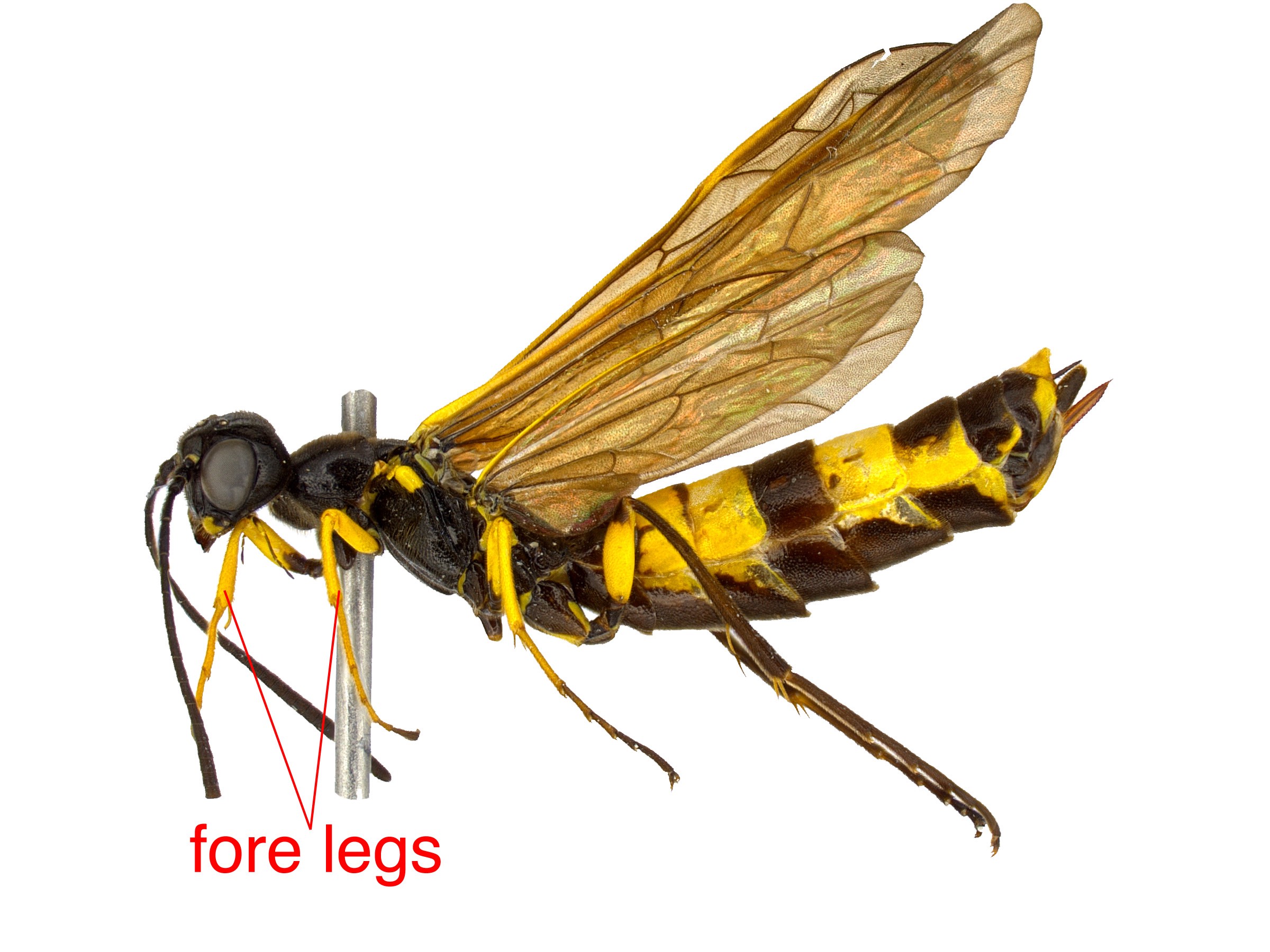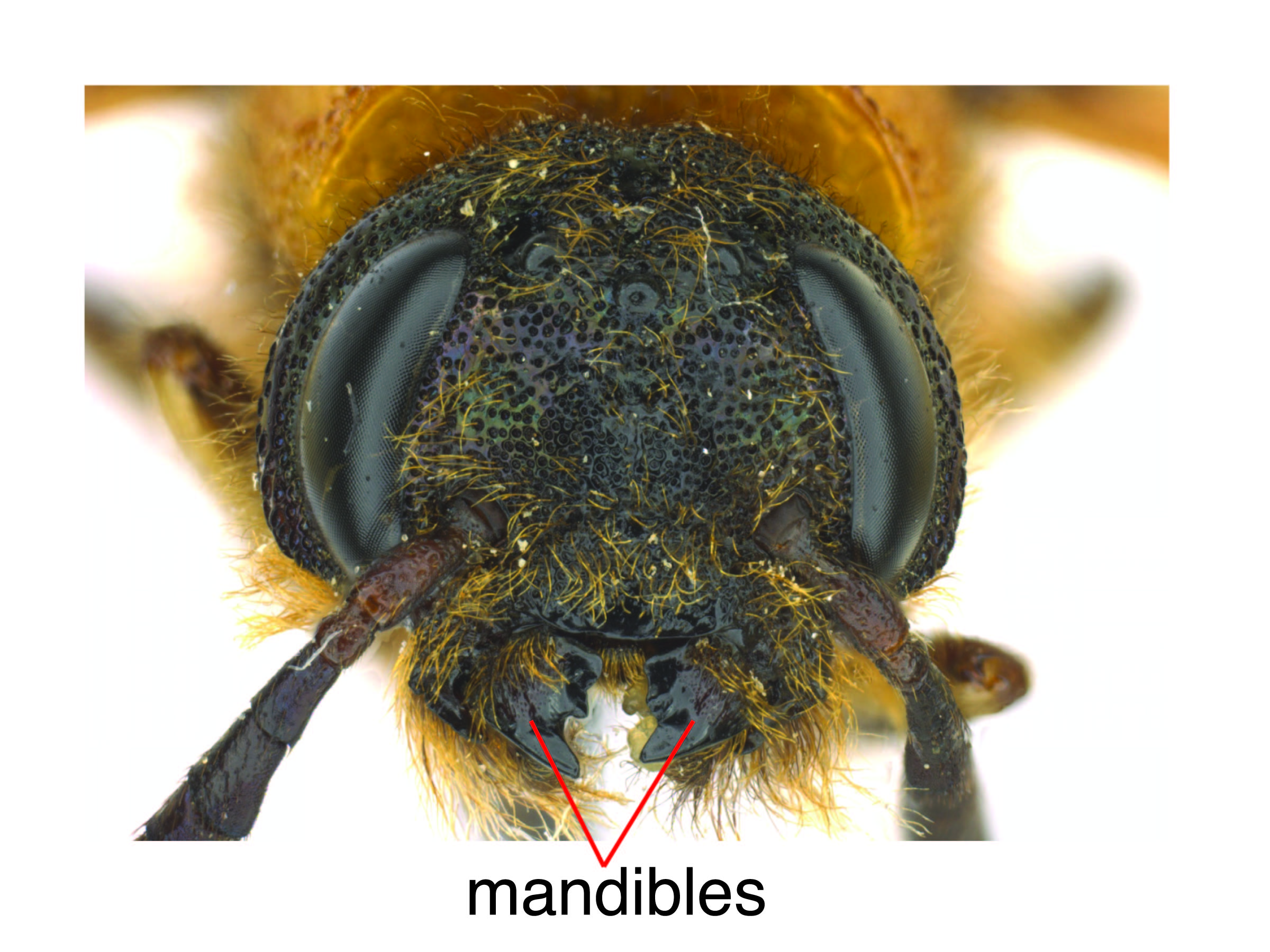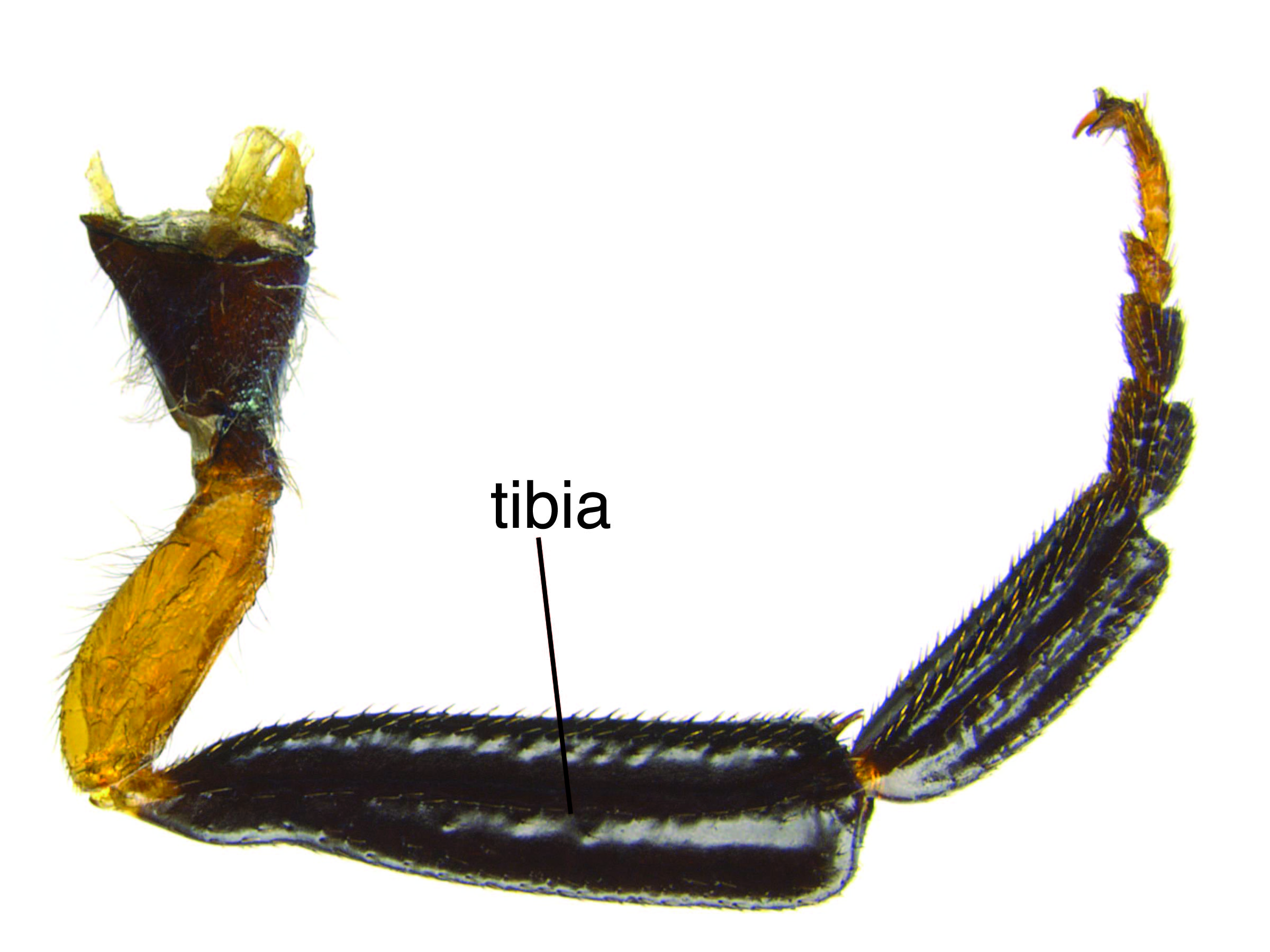Family: Pamphiliidae
Family common name: web-spinning and leaf-rolling sawflies
Subfamily: Cephalciinae
Tribe: Cephalciini
Genus: Acantholyda Costa, 1894
Subgenera: Acantholyda, Itycorsia
The Pamphiliidae are called the web-spinning and leaf-rolling sawflies due to their larval shelter-building behavior (Goulet 1992Goulet 1992:
Goulet H. 1992. The genera and subgenera of the sawflies of Canada and Alaska: Hymenoptera. Symphyta. The insects and arachnids of Canada. Part 20. Agriculture Canada Publication.).
Acantholyda adults are about 10–17 mm in length with long thread-like antennaeantenna:
the sensory organ emerging from the front of the head, usually between the compound eyes and above the clypeus; includes the flagellum, scape and pedicel
 . There are two subgenera that can be distinguished by a ridge behind the eye. They have distinctive larval habits that involve building elaborate nests of webs, leaf material, and frassfrass:
. There are two subgenera that can be distinguished by a ridge behind the eye. They have distinctive larval habits that involve building elaborate nests of webs, leaf material, and frassfrass:
solid larval excrement
, inside of which they feed and keep safe from predators. Some species are significant pests of coniferconifer:
a usually evergreen tree characterized by reproductive cones; e.g., pine, fir, spruce, larch, etc.
trees (Middlekauff 1958Middlekauff 1958:
Middlekauff WW. 1958. The North American sawflies of the genera Acantholyda , Cephalcia , and Neurotoma (Hymenoptera, Pamphiliidae). University of California Publications in Entomology 14 (2): 51-174., Shinohara and Byun 1996Shinohara and Byun 1996:
Shinohara A and Byun BK. 1996. Conifer-feeding web-spinning sawflies of the genus Acantholyda (Hymenoptera, Pamphilidae) from Korea. Ins. Koreana 13: 91-104. https://doi.org/10.12782/specdiv.6.23).
There are 78 described species worldwide. Thirty-seven species occur in North America, including one introduced from Europe (Taeger et al. 2010Taeger et al. 2010:
Taeger A, Blank SM, and Liston AD. 2010. World Catalog of Symphyta (Hymenoptera). Zootaxa 2580: 1-1064.).
A Key to North American species of Acantholyda is included in Middlekauff 1958Middlekauff 1958:
Middlekauff WW. 1958. The North American sawflies of the genera Acantholyda , Cephalcia , and Neurotoma (Hymenoptera, Pamphiliidae). University of California Publications in Entomology 14 (2): 51-174..
 from above slightly constricted, without two distinct faces, more or less evenly flat from the dorsum to the anterioranterior:
from above slightly constricted, without two distinct faces, more or less evenly flat from the dorsum to the anterioranterior: with 2 apicalapical:
with 2 apicalapical: with 3–4 preapicalpreapical:
with 3–4 preapicalpreapical: tibial spurs (Goulet 1992Goulet 1992:
tibial spurs (Goulet 1992Goulet 1992: width at basebase:
width at basebase: with small inner tooth (Goulet 1992Goulet 1992:
with small inner tooth (Goulet 1992Goulet 1992: membrane wrinkled irregularly at the apexapex:
membrane wrinkled irregularly at the apexapex: long and slender with a small inner tooth (Middlekauff 1958Middlekauff 1958:
long and slender with a small inner tooth (Middlekauff 1958Middlekauff 1958: spur on the inner side of the fore tibiafore tibia:
spur on the inner side of the fore tibiafore tibia: (Goulet 1992Goulet 1992:
(Goulet 1992Goulet 1992:Pamphiliidae are recognized by a somewhat quadratequadrate:
square-like or cube-like in shape
 head and tarsal claws with inner teeth. Acantholyda can be distinguished from Cephalcia by the preapicalpreapical:
head and tarsal claws with inner teeth. Acantholyda can be distinguished from Cephalcia by the preapicalpreapical:
close to, but anterior to, the apex
 spur on the inner side of fore legfore leg:
spur on the inner side of fore legfore leg:
the first and anterior-most leg of the body
 and from other genera in the family by the small inner tarsal clawtarsal claw:
and from other genera in the family by the small inner tarsal clawtarsal claw:
sharpened appendage emerging from the apex of the tarsus
 tooth (Goulet 1992Goulet 1992:
tooth (Goulet 1992Goulet 1992:
Goulet H. 1992. The genera and subgenera of the sawflies of Canada and Alaska: Hymenoptera. Symphyta. The insects and arachnids of Canada. Part 20. Agriculture Canada Publication.).
Acantholyda nipponica, a closely related species to A. erythrocephala, is a pest of Larix leptolepis (Japanese larch) in Japan. This species also feeds on several Pinus sp. (pine). Acantholyda sasakii was recorded as a pine pest in in the early 1900s, with Pinus densiflora (Japanese red pine) a known host plant (Shinohara 2001Shinohara 2001:
Shinohara A. 2001. Conifer-feeding web-spinning sawflies of the genus Acantholyda (Hymenoptera: Pamphiliidae) of Japan. Japanese Society of Systematic Zoology-Species Diversity 6: 23-63.).
Acantholyda posticalis is a significant defoliatordefoliator:
an insect that defoliates
of pines in Europe and Central Asia, most notably of Pinus sylvestris (Scots pine). Outbreaks have been reported in Poland, Germany, Russia, and Kazakhstan. In Lithuania during the 1970s, an outbreak damaged over 14,300 acres of pine forest (Voolma et al. 2009Voolma et al. 2009:
Voolma K, Pilt E, and Õunap H. 2009. The first reported outbreak of the great web-spinning pine sawfly, Acantholyda posticalis (Mats.) (Hymenoptera, Pamphiliidae), in Estonia. Forestry Studies 50: 115-122. https://doi.org/10.2478/v10132-011-0072-z). Northern populations of this species have a documented cold tolerance of more than -20°C, and it is being monitored for range expansion to the north (Voolma et al. 2016Voolma et al. 2016:
Voolma K, Hiiesar K, Williams, IH, Ploomi A, and Jogar K. 2016. Cold hardiness in the pre-imaginal stages of the great web-spinning pine sawfly Acantholyda posticalis . Agricultural and Forest Entomology 18: 432-436. https://doi.org/10.1111/afe.12172). This adaptability may increase the chances of successful establishment in North America.
Larvae feed on needles of numerous species of Pinaceae. Host species of pine include: Pinus taeda (loblolly pine), Pinus contorta (lodgepole pine), Pinus ponderosa (ponderosa pine), Pinus muricata (bishop pine), Pinus resinosa (red pine), P. banksiana (jack pine), P. strobus (eastern white pine), Pinus rigida (pitch pine), Pinus mugo (mountain pine), Pinus sylvestris (Scots pine), Pinus densiflora (Japanese red pine), Pinus nigra (black pine), Pinus radiata (Monterey pine), Pinus sabiniana (foothill pine), Pinus edulis (Colorado pinyon), Pinus elliottii (slash pine), Pinus clausa (sand pine), Pinus monticola (western white pine), and Pinus pungens (table mountain pine). Other hosts are trees of Tsuga heterophylla (western hemlock), Pseudotsuga menziesii (Douglas fir), Picea glauca (white spruce), Picea sitchensis (Sitka spruce), Picea mariana (black spruce), and other Picea sp. (Middlekauff 1958Middlekauff 1958:
Middlekauff WW. 1958. The North American sawflies of the genera Acantholyda , Cephalcia , and Neurotoma (Hymenoptera, Pamphiliidae). University of California Publications in Entomology 14 (2): 51-174., Greenbaum 1975Greenbaum 1975:
Greenbaum HN. 1975. A new species of Acantholyda from Florida, with keys to the adults and larvae of Florida species (Hymenoptera: Pamphiliidae: Cephalciinae). The Florida Entomologist 58 (1): 45-52.).
The female makes a small slit in the side of a mature needle and deposits eggs so that the membrane gets caught in the slit, ensuring the eggs stay in place on the outside of the needle, yet allowing the eggs to be in contact with vascular tissue to obtain moisture. After hatching, the larvaelarva:
the immature stage of holometabolous insects
 commence building a structure out of silk and plant material for protection, within which they safely feed. Some species feed gregariously. They eat by using mandibles to cut small needles at the basebase:
commence building a structure out of silk and plant material for protection, within which they safely feed. Some species feed gregariously. They eat by using mandibles to cut small needles at the basebase:
the beginning or most proximal area of any structure
, then bringing the needle to the shelter, and devouring it from basebase:
the beginning or most proximal area of any structure
to apexapex:
the end or most distal area of any structure
. Mature larvaelarva:
the immature stage of holometabolous insects
 measure up to 25 mm in length, have reduced prolegs and are variable in color (Middlekauff 1958Middlekauff 1958:
measure up to 25 mm in length, have reduced prolegs and are variable in color (Middlekauff 1958Middlekauff 1958:
Middlekauff WW. 1958. The North American sawflies of the genera Acantholyda , Cephalcia , and Neurotoma (Hymenoptera, Pamphiliidae). University of California Publications in Entomology 14 (2): 51-174.).
When mature, larvaelarva:
the immature stage of holometabolous insects
 fall to the ground and burrow into the soil to a depth of about 5–8 cm. The prepupaprepupa:
fall to the ground and burrow into the soil to a depth of about 5–8 cm. The prepupaprepupa:
the active, non-feeding life stage in which the larva prepares to enter the pupal stage
overwinters in a small cellcell:
1. a membranous area of the wing between veins, 2. a small cavity or closed space
 built from soil and silk. In spring, it pupates and emerges. Adults generally fly in spring, during April and May. Many Acantholyda are univoltineunivoltine:
built from soil and silk. In spring, it pupates and emerges. Adults generally fly in spring, during April and May. Many Acantholyda are univoltineunivoltine:
describing an insect with a life cycle of one generation per year
(Middlekauff 1958Middlekauff 1958:
Middlekauff WW. 1958. The North American sawflies of the genera Acantholyda , Cephalcia , and Neurotoma (Hymenoptera, Pamphiliidae). University of California Publications in Entomology 14 (2): 51-174.).
Acantholyda erythrocephala, commonly known as the pine false webworm, is a significant pest of pine trees and has historically caused severe defoliation in North America, Europe, and Asia (Middlekauff 1958Middlekauff 1958:
Middlekauff WW. 1958. The North American sawflies of the genera Acantholyda , Cephalcia , and Neurotoma (Hymenoptera, Pamphiliidae). University of California Publications in Entomology 14 (2): 51-174.). For example, 570,000 acres in New York was heavily infested between 1989 and 1999 (Asaro and Allen 2001Asaro and Allen 2001:
Asaro C and Allen DC. 2001. History of a pine false webworn (Hymenoptera: Pamphiliidae) outbreak in northern New York. Canadian Journal of Forest Research 31: 181-185. https://doi.org/10.1139/cjfr-31-1-181). Damage sustained by trees from several years of feeding by A. erythrocephala can provide habitat for secondary pests such as bark beetles, and can result in mortality. Christmas tree plantations often sustain significant economic losses due to the presence of this pest (Kenis and Kloosterman 1999Kenis and Kloosterman 1999:
Kenis M and Kloosterman K. 1999. European parasitoids of the pine false webworm ( Acantholyda erythrocephala (L.)) and their potential for biological control in North America. In: Liebhold AM, McManus ML, Otvos IS, Fosbroke SLC eds. 2001. Proceedings: integrated management and dynamics of forest defoliating insects: Victoria, British Columbia 1999 August: 65-73.).
World: Outside of the Americas, the range of Acantholyda is restricted to the Northern Hemisphere, with species known throughout Europe, and in Asia east to Korea and Japan (Shinohara and Byun 1996Shinohara and Byun 1996:
Shinohara A and Byun BK. 1996. Conifer-feeding web-spinning sawflies of the genus Acantholyda (Hymenoptera, Pamphilidae) from Korea. Ins. Koreana 13: 91-104. https://doi.org/10.12782/specdiv.6.23, Taeger et al. 2010Taeger et al. 2010:
Taeger A, Blank SM, and Liston AD. 2010. World Catalog of Symphyta (Hymenoptera). Zootaxa 2580: 1-1064.).
North America: Acantholyda are common in forested regions of northern North America (Middlekauff 1958Middlekauff 1958:
Middlekauff WW. 1958. The North American sawflies of the genera Acantholyda , Cephalcia , and Neurotoma (Hymenoptera, Pamphiliidae). University of California Publications in Entomology 14 (2): 51-174.). Four species are known to occur in Mexico, as far south as Veracruz (Smith 1988Smith 1988:
Smith DR. 1988. A synopsis of the sawflies (Hymenoptera: Symphyta) of America south of the United States: introduction, Xyelidae, Pamphiliidae, Cimbicidae, Diprionidae, Xiphydriidae, Siricidae, Orussidae, Cephidae. Systematic Entomology 13: 205-261.). Acantholyda erythrocephala, an introduced European species, was first discovered in Pennsylvania in 1925. It spread east to New Jersey, New York, and New England, then west to Wisconsin, Ontario, and Alberta (Middlekauff 1958Middlekauff 1958:
Middlekauff WW. 1958. The North American sawflies of the genera Acantholyda , Cephalcia , and Neurotoma (Hymenoptera, Pamphiliidae). University of California Publications in Entomology 14 (2): 51-174., Asaro and Allen 2001Asaro and Allen 2001:
Asaro C and Allen DC. 2001. History of a pine false webworn (Hymenoptera: Pamphiliidae) outbreak in northern New York. Canadian Journal of Forest Research 31: 181-185. https://doi.org/10.1139/cjfr-31-1-181).
Map data from: GBIF.org (26 June 2019) GBIF Occurrence Download Acantholyda
Details about data used for maps can be found here.